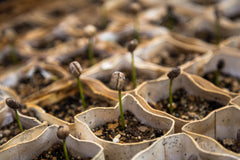 Of the three world regions ideally suited to grow coffee—Africa, Indonesia, and the Americas—the last region introduced to the coffee tree is the world's premier coffee producer today. That region is the Americas.
Of the three world regions ideally suited to grow coffee—Africa, Indonesia, and the Americas—the last region introduced to the coffee tree is the world's premier coffee producer today. That region is the Americas.The centuries-old odyssey of coffee's cultivation around the globe, its humble beginnings as a medicinal herb in Ethiopia to its standing as the second most traded global commodity after oil, and its stunning influence on world culture speaks to the extraordinary allure and resilience of a simple cherry seed. The history of coffee in the Americas provides the closing chapter to coffee's storied past and quite literally brings its travels full circle.
Ever the earnest profiteers, the Dutch introduced arabica coffee trees to Central and South America in 1718. Twenty years earlier, tiny Holland had imported the first coffee plants to Indonesia. Their wise purchase of offspring from Baba Budan's famed coffee seeds enabled the Dutch to propagate seedlings sufficient to cultivate their East Indian colonies, grow their Dutch East India coffee trade into a commercial empire, and bestow on world leaders in grandiose fashion their very own coffee trees.
 A coffee tree presented to Louis XIV by the Dutch in 1715 and nurtured in Paris's Royal Botanical Garden would make an indelible mark on coffee's history with the help of a resolute French naval officer. On leave from Martinique in 1720, Gabriel Mathieu de Clieu was convinced that Martinique could become as successful a coffee producer as Java. When his request for a coffee plant grown from the king's noble tree was summarily denied, de Clieu staged a late night raid on the Royal Garden to secure one of the plants himself. Although de Clieu's daring effort was successful, it actually proved less harrowing than his perilous transatlantic return to Martinique, as he was compelled to share his meager water rations with the fledgling tree. But within 50 years of the plant's arrival on Martinique, de Clieu's heroics literally bore fruit. The confiscated plant yielded over 18,000 coffee trees.
A coffee tree presented to Louis XIV by the Dutch in 1715 and nurtured in Paris's Royal Botanical Garden would make an indelible mark on coffee's history with the help of a resolute French naval officer. On leave from Martinique in 1720, Gabriel Mathieu de Clieu was convinced that Martinique could become as successful a coffee producer as Java. When his request for a coffee plant grown from the king's noble tree was summarily denied, de Clieu staged a late night raid on the Royal Garden to secure one of the plants himself. Although de Clieu's daring effort was successful, it actually proved less harrowing than his perilous transatlantic return to Martinique, as he was compelled to share his meager water rations with the fledgling tree. But within 50 years of the plant's arrival on Martinique, de Clieu's heroics literally bore fruit. The confiscated plant yielded over 18,000 coffee trees. Much of the world's coffee, including the majority of the coffee destined for cultivation in the Americas, is descended from that single tree. By 1727 Brazil's emperor was neither interested in purchasing coffee from Martinique, nor pleased with the Dutch-owned coffee plantations established a decade earlier in the South American colony of Surinam, the French Guinea, and at Para in Brazil. The emperor yearned for control of his own coffee industry and devised a plan to smuggle coffee seedlings out of an unsuspecting French Guinea.
Under orders to execute the plan, Colonel Francisco de Melo Palheta traveled to French Guiana under the guise of resolving a border dispute. Unable to gain entrance to the fortress-like coffee farms there, the suave Colonel Palheta chose the next best option: the governor's wife. In due time, the woman presented Palheta with a token of affection: a bevy of coffee seedlings buried in a floral bouquet.
 Those few seedlings would build the world's greatest coffee empire, promote coffee cultivation throughout Latin America, and lead to Brazil's monstrous coffee yields destined to lower world prices. Coffee would be transformed from a luxurious indulgence reserved for the privileged to an affordable luxury accessible to the masses.
Those few seedlings would build the world's greatest coffee empire, promote coffee cultivation throughout Latin America, and lead to Brazil's monstrous coffee yields destined to lower world prices. Coffee would be transformed from a luxurious indulgence reserved for the privileged to an affordable luxury accessible to the masses.
 Those few seedlings would build the world's greatest coffee empire, promote coffee cultivation throughout Latin America, and lead to Brazil's monstrous coffee yields destined to lower world prices. Coffee would be transformed from a luxurious indulgence reserved for the privileged to an affordable luxury accessible to the masses.
Those few seedlings would build the world's greatest coffee empire, promote coffee cultivation throughout Latin America, and lead to Brazil's monstrous coffee yields destined to lower world prices. Coffee would be transformed from a luxurious indulgence reserved for the privileged to an affordable luxury accessible to the masses.